ON THE FACE OF THINGS
Unlike other less visible accoutrements such as hosiery or shirt cuffs, the shirt collar is an integral and highly revealing gesture of personal style. All sophisticated dressers have arrived at one or more collar styles that best highlight their unique features while adding a bit of dash along the way. The following men illustrate how their physiognomy and sense of style include enced their choice of dress shirt collar.
THE STRAIGHT-POINT COLLAR
Because the straight point collar was the collar shape gracing most military issued dress shirts since WWI, it has long been the foundation of the modern man’s dress shirt wardrobe. As the most stylistically neutral of all collars, the straight point collar can be worn with any kind of suit or sport jacket. Ideally, its collar points should finish between 7 cm and 8.5 cm in length. The narrow opening between its points favors a rounder, oval-shaped face, rather than a narrow one.
Here is a man who chose to title his autobiography It Tech Nine Tailors. As one of Hollywood‘s great early leading men. Adolphe Menjou was also one of its leading dandies. Here he is tailored to his measure in a long point collar with just the right amount of calculated disobedience to play the harried political boss in Frank Capra’s The Man Behind the President. His collar’s casual deportment not only defangs his aggressively striped bespoke suiting but also serves to elongate his oval contours.
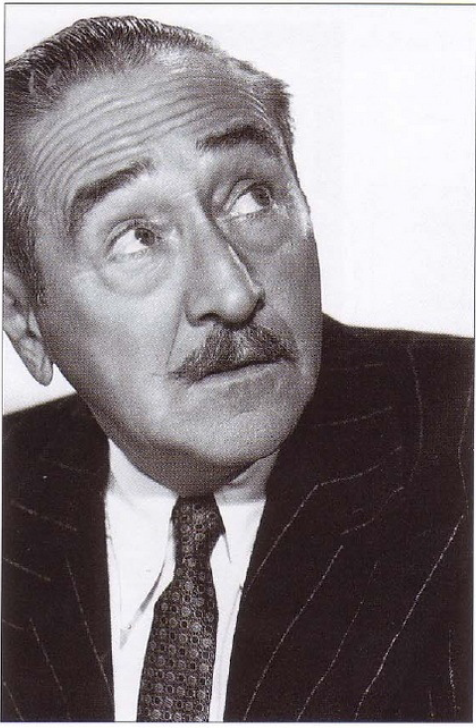
lf you were feeling uneasy that this collar presentation was overly ballyhooed, consider the next victim. Here’s a dress shirt performance that is definitely laying an egg. England’s Leslie Howard is pictured taking a stroll on deck as he returns to Europe aboard the SS Berengaria (and let’s hope to a good Jermyn Street chemisier). How he has managed to come up with exactly the wrong collar.
For his face is anyone’s guess. Its long and very perpendicular lines pick up where those of his face leave off, rendering his already gaunt visage even more lank. If there ever was a prime candidate for a spread, collar shirt. Master Howard would be it.
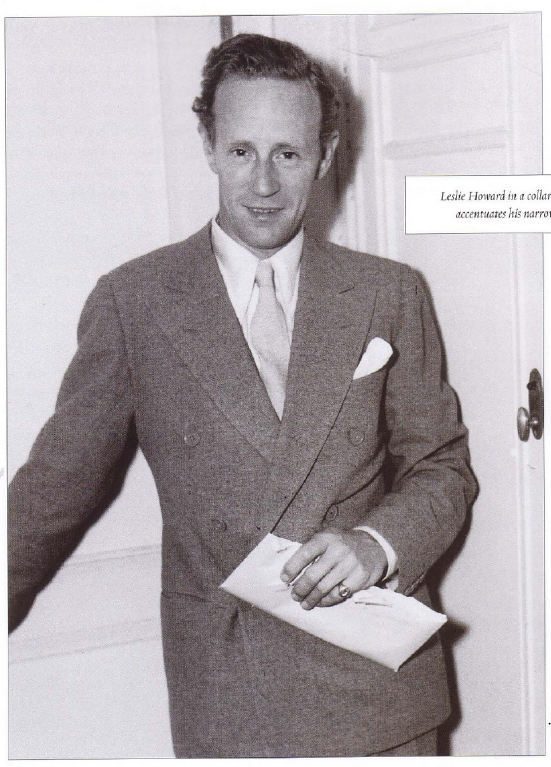
THE SPREAD COLLAR
The spread collar has been the keystone of the English bespoke look since the double collar came to town during the early 1920s. Its introduction is widely attributed to the famous Prince of Wales, probably due to his alleged creation of the Windsor knot that was supposed to escort it. In fairness, it was really his younger brother. the Duke of Kent. who first popularized it.
Because of the spread’s inherently dressy and elegant bearing, it has become today’s most important dress shirt collar. As spread collars vary greatly in height, point length, and openness, there are usually several models that will flatter any man’s head shape or profile. If only for variety, some version of the spread collar should be a permanent Fixture in all men’s wardrobes.
Although Prince Charles mars this perfect tableaux of royal shirtmaking by being caught with his finger in his ear, his collar architecture is spot-on. The height, point length. and spread of his Turnbull & Asser glen plaid collar points are perfectly symmetrical with the contours of his face. Notice how the collar’s points touch his chest while remaining tucked under his coat’s front, even when his head is turned, one of the spread’s practical advantages over other models. In addition, the dimple of his four-in-hand knot falls directly under the “V” point at the collar’s top. And just for good measure, notice that his sleeve cuff has not receded from view, even when his arm extends, courtesy of its longer sleeve and close lit of its cuff around his wrist. Because the majority of Italian men are smaller-boned, most fancy some version of the spread collar. Fabio Borelli, one of Italy’s new generation of shirt-making scions, is no exception. As his face tapers down almost to a point. the spread collar is. in Fact. the only possible design able to counteract such a contour.

Borelli has employed a higher-sitting spread collar to better frame his face while tinkering with tradition with typical Italian sprezzatura (bottom left). Don’t think for a minute that his collar slight bowing, the minutely skewed angle of his knot. or even the peaking of his tie’s under blade happen to be coincidence. To the contrary, this demonstration of noblesse negligence is another reminder of an almost cultural predisposition by Italy‘s style cognoscenti to continually rework the canons of English taste. Who says that the male species is any less decorative minded than the female? However, like most aspects of stylish habiliment, true elegance resides not in the clothes themselves but in how they are worn.
Here‘s the spread collar cum Windsor knot‘s most indefatigable champion, the late actor and author Douglas Fairbanks Jr. The moment this collar and knot team hit London. Junior immediately adopted it, eventually becoming its lifelong ambassador. Fairbanks’s enthusiasm may have had as much to do with the large knot and collar’s early acceptance by the beau monde as with its alleged instigator, the Duke of Windsor.
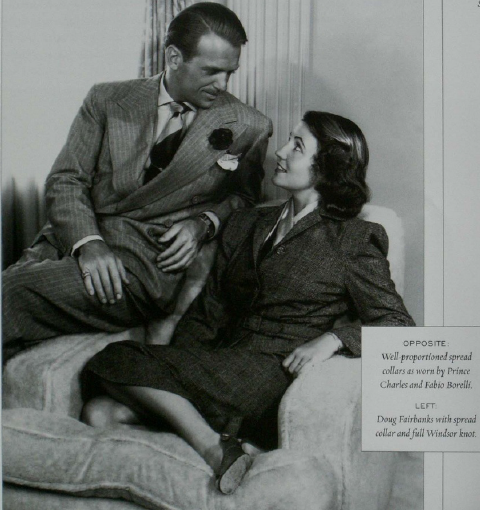
THE ROUNDED COLLAR
The short, stiff round collar has been an obligatory part of the Eton school uniform since the mid-nineteenth century. Originally a separate stiff white collar that attached to a banded collar shirt body, early on the collar signified membership in one of the world’s exclusive male clubs, hence its moniker, the “club” collar. The famous Arrow collar ads in the early twentieth century helped to elevate this style of collar to the pantheon of classic dress shirt Collars
As a soft attached collar, the club collar became one of the 1930s most popular collar shapes to be worn pinned. Its curves played particularly well under the decades athletically chiselled Visage. Although the club collar rarely cavorts among the masses, this holdover from Victorian society can occasionally be found hobnobbing with the custom tailored set.
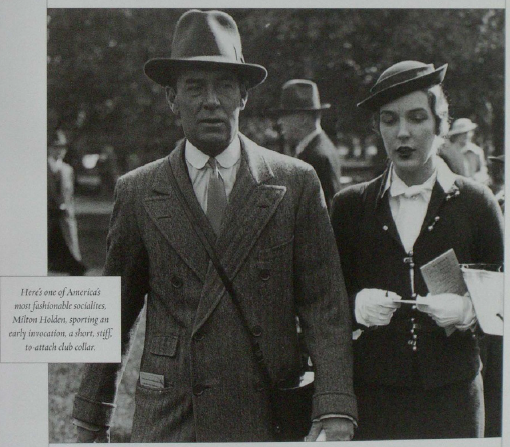
THE TAB COLLAR
The Prince of Wales is generally credited with introducing the tab collar to high society. Coming into its own during the late 1920s and early 1930s, it flirted briefly with fashion once again in the 1960s. Although its popularity has waned due to the inexorable casualization of male fashion, the tab collar remains a favorite of those seeking that extra nuance of inattiness.
The tab collar must be designed perfectly for the tie knot to rest comfortably in its opening. Special tabs fasten to each other under the ties knot to hold the collar’s points in place thrusting the shirt collar and necktie knot higher up under the wearer’s chin. Long-necked men welcome the tab’s higher positioning. while the round or square-shaped visage appreciates its longitudinal symmetry. Originally, a special blass stud secured the collar to the neckband while connecting the collar tab. Today, with pre-attached tab collar dress shirts, a snap or a button and buttonhole apparatus are usually substituted. However, as with most old-world wearables. the original brass stud still projects a more polished sophistication than its less visual modern surrogates.
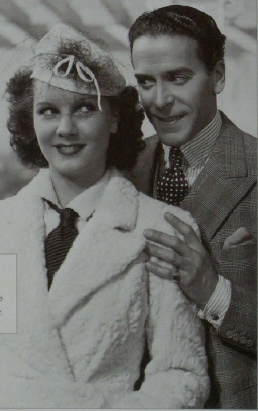
Britain‘s answer to the stylish supremacy of America’s Fred Astaire was their own story thespian and limiter Jack Buchanan. To be called a “Buchanan” was a compliment. suggesting the recipient knew his way around a fitting room. And this Buchanan guy could outfit himself with the best of them.
PINNED COLLARS
At one point during the 1930s. nearly half of all American men reportedly wore their dress shirt collars pinned. Today. it would be surprising to find one man in a hundred so appointed. Some men find the pinned collar fussy; most men are simply intimidated by its obligatory rigging.
Considered by many shirt savants to be the pinnacle of collared carriage, this is not neck trapping to hide behind. Unlike the cutaway or button-down, the pinned collar’s stylishness rises or falls in relation to the skill of its execution. Wearing it with panache demands a little practice, some manual dexterity, and a bit of patience.
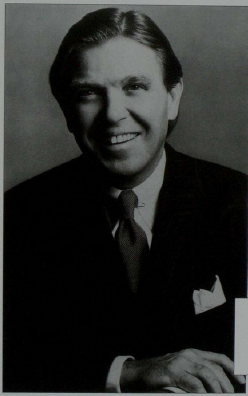
Functioning much like the tab, the pinned collar raises the tie knot up on the neck, shortening the long neck. The straight points’ verticality work to counterpoint the rounded or oral contoured head or chin. Back in their heyday in the thirties, straight-point collars were finished at between 7.5 cm and 9 cm long. making them natural candidates for pinning up. The most common apparatus was a plain gold safety pin: next was a sort of spring-loaded slide mechanism: while the aficionado used a bar with shaped ends that unscrewed to fit through specially made collar eyelets. The next step in such collar accoutrement was to acquire one decorated with a sporting motif such as a golf club, polo mallet, or riding crop.
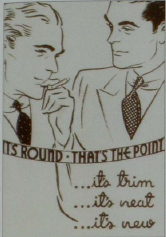
Following the same principle of stylish neck rigging. the pinned club collar transports one quietly out of the ordinary: Fastening snugly beneath the tie knot, the rounded collar elevates the wearer’s collar height, and its softer, rounder outline harmonizes particularly well with the square or angular jawline. With no points to curl up. bend over. or go mice”: the rounded pin collar remains trim and tidy throughout the day.
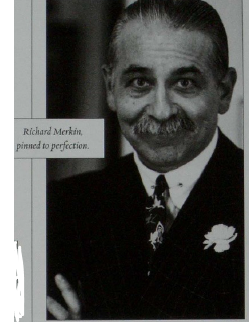
THE BUTTON-DOWN COLLAR
Initially popularized by American sportsmen and Eastern university men during the 1920s and 1930s, the oxford button-down is America’s sole contribution to the lexicon of permanent dress shirt fashion. Since World War II, European enthusiasts have descended upon the doorstep of its shrine, 346 Madison Avenue, to load up on this unique American classic. Until recently, no elegant male could unfurl his stripes without at least one Brooks Brothers pink oxford gracing his closet.
With designer menswear helping to blur the distinction between the disposable and permanent fashion. Brooks Brothers has further muddied the waters by abdicating its role as the protectorate of America’s traditional fashion. As goes Brooks, so goes the button-down. The Ivy League look was the last patrician-inspired men’s fashion to establish itself before the roots of America’s upper-class taste were displaced in the upheaval of the 1960s Peacock Revolution. Were it not for the vision and genius of Ralph Lauren, America’s very own natural-shoulder style would have followed his alma mater, Brooks Brothers, in m sartorial eclipse.
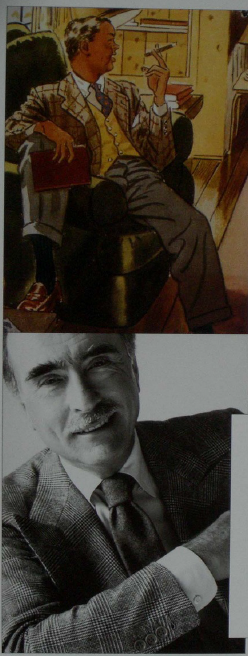
Traditionally clad Continentals have always appreciated the American original’s innate classiness. Each year, a small coterie of French and Italian merchants offers up its take on the Ivy League look, inspired by Old World images of American society at play in Newport or Palm Beach.
When hosting a necktie, the button-down collar projects about the same level of dressiness as the navy blazer or Weejun-style loafer, two of its more frequent coconspirators. Like the blue blazer, the oxford button-down can be dressed up or down, although it tends to consort more comfortably with like texture fabrics such as flannel or tweed. In the button down’s salad days, all style was forfeited, should its points lack sufficient length to roll over and play casually.
Hi everyone, we finished the shirts series. We hope the few articles will help you know more about the shirt and you can choose them at least one good for you.
Source: Dressing the Man Mastering the Art of Permanent Fashion by Alan Flusser

